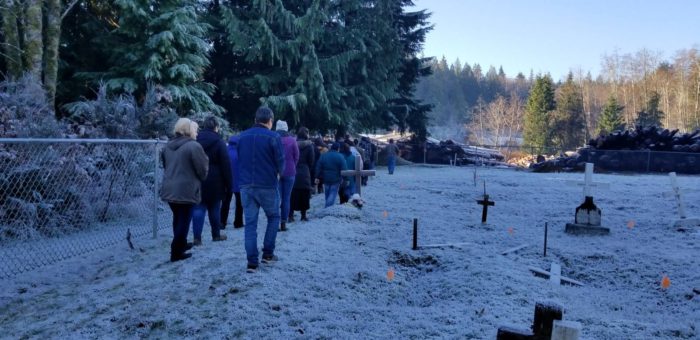Klahoose expands global repatriation efforts with database, app
This winter, Klahoose Elder Kenny Hanuse led a procession of band members from the nation’s main office to the community’s cemetary in Squirrel Cove for the burial of two ancestors returning home.
Klahoose youth Brandon Harry and Chief Kevin Peacey carried small cedar boxes containing the remains of the ancestors, recently repatriated from the Royal B.C. Museum.
As the group made their way to the burial plots, elders greeted the ancestors, calling to them in their language and letting them know they can finally go to rest.
“Our ancestors have come home, this is truly a happy day for them, and for those of us here to greet them,” said Peacey.
The ceremony was the result of a wider project that Klahoose has been focusing on for the past year called “The Journey Home: ʔi:mot tətᶿ kʷənome (it’s good to see you).”
After receiving a grant from the Museum Assistance Program of the Canadian Department of Heritage, the nation has been reaching out to hundreds of institutions around the world to return ancestors and items of cultural significance back to Klahoose.
During Naut’sa mawt Tribal Council’s Annual General Meeting in January, Peacey and Klahoose Director of Cultural Affairs and Heritage Jodi Simkin shared the nation’s work with leaders from other Coast Salish communities.
Simkin explained that the project began by using non-invasive ground-penetrating radar in the nation’s existing cemeteries and giving the newly discovered ancestors GPS coordinates.
“In the case of Squirrel Cove, we started with 204 known graves, and we found 98 additional inferred graves,” she said.
“In the case of Toba Inlet, we started with three and located 48.”
Simkin said even with finding those graves, it became clear that there weren’t enough to account for how many people have lived at Klahoose over the years — the nation estimates that there should be approximately 650 sets of remains, but has only accounted for 342.
So Klahoose started seeking out remains from museum collections as part of The Journey Home.
Through the project, the nation has compiled a growing worldwide database of about 410 institutions.
Simkin said the list will be available to all nations once work is complete.
“This is a project for all of Canada, that all of the nations here can actually do fairly easily now that this part of the work has been done,” Simkin said.
“Our hope is that, as you take the list, and if you add institutions to it, that you will send it back to us so we can keep the list going and growing.”
To build on its repatriation work, Klahoose is also working on developing a mobile progressive app called “the Mountain and the Mouse.”
The nation has partnered with the Museum of Anthropology, the Royal B.C. Museum, the Museum of Vancouver and a group of other First Nations on the technology.
The app will allow museum-goers around the world to capture information on art and artifacts they encounter, then relay that information back to participating nations.
“They open the app, it will work on- or offline, and they simply fill in the fields,” Simkin explained.
“As soon as they hit ‘send’ it will notify the (originating) nation.”
Simkin said the web app, when its ready, will be a way for the public to support repatriation efforts. Klahoose will work with B.C. nations first before looking at expanding the project across Canada.
Simkin said the nation is waiting on final funding before the app is released to the public, but updates, when available, can be found at www.klahoose.org.




